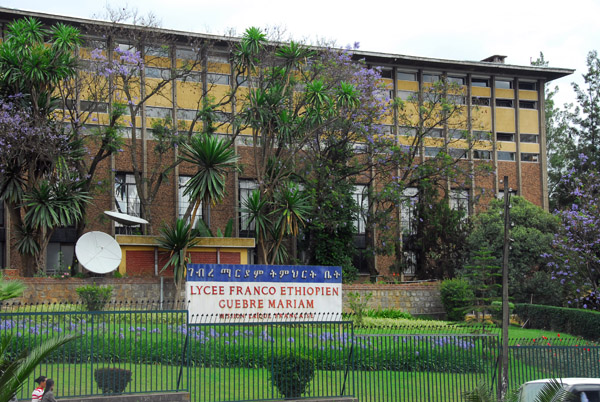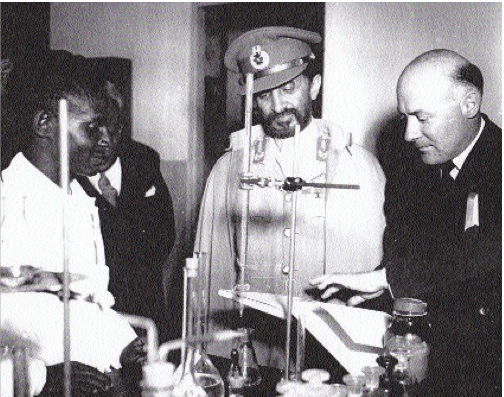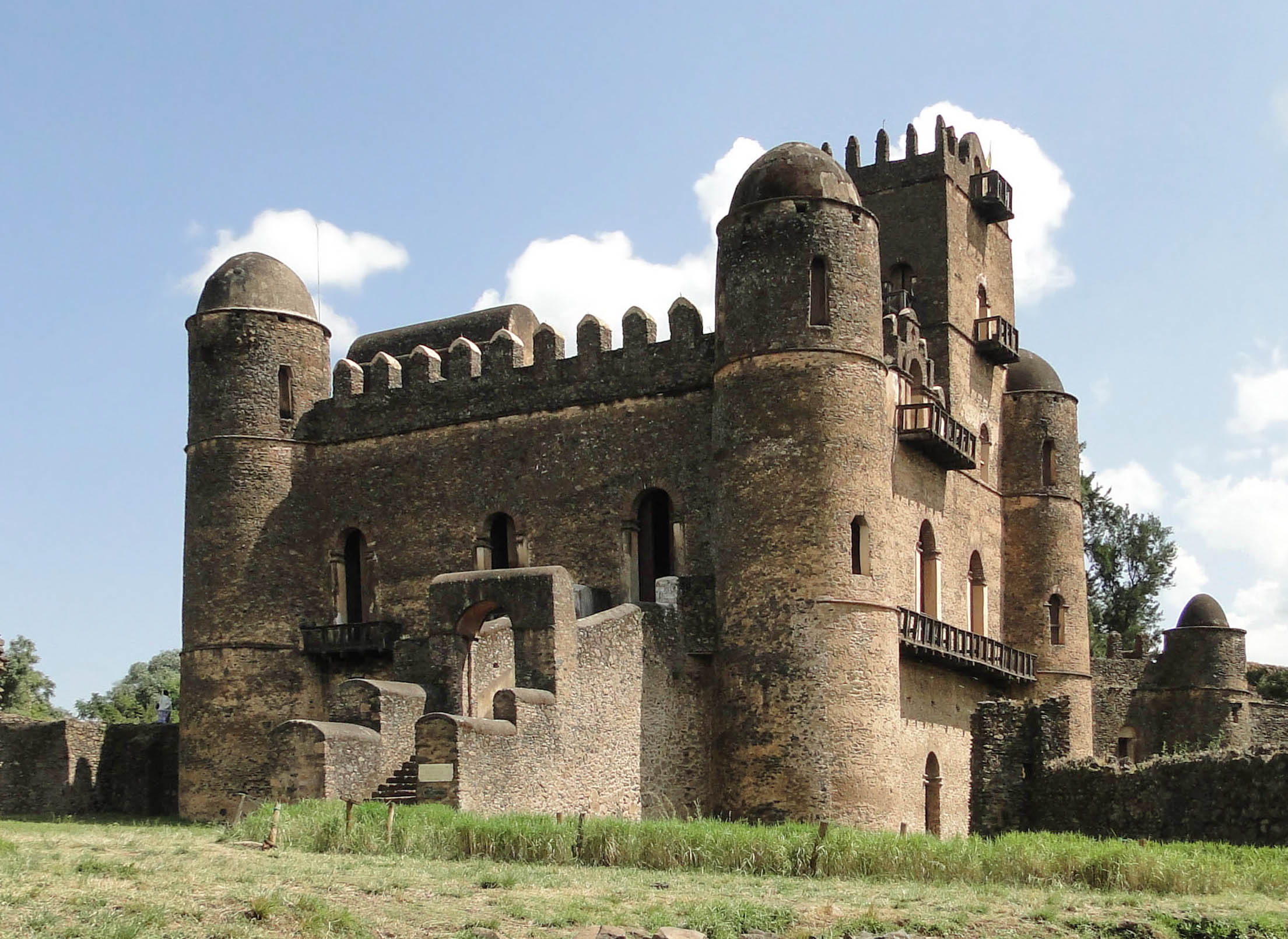|
University Of Gondar
The University of Gondar, until 2003 known as the Gondar College of Medical Sciences, is the oldest medical school in Ethiopia. Established as the Public Health College in 1954, it is located in Gondar, in Amhara Region of Ethiopia. In 2010, the university offered 42 undergraduate and 17 postgraduate programs. As of 2016, the university offers 56 undergraduate and 64 postgraduate programs. These are organized under the College of Medicine and Health Sciences, College of Business and Economics, College of Natural and Computational Sciences, College of Social Sciences and Humanities, and Faculty of Veterinary Medicine and Faculty of Agriculture, and three schools (School of Law, School of Technology and School of Education). The current president of the university is Dr. Asrat Atsedeweyn. History The Public Health College was established following an agreement signed by the acting Ethiopian minister of public health, Marsae Hazan Wolde Qiros, and the government of the United Sta ... [...More Info...] [...Related Items...] OR: [Wikipedia] [Google] [Baidu] |
Asrat Atsedeweyn
Asrat Atsedeweyn is an Ethiopian statistician, academic administrator, servant leader and politician currently serving as president of University of Gondar, University of Gondar, Ethiopia. He was previously Academic Vice President of the University of Gondar. He also holds Government office as a Representative of the House of Peoples in one of 10 regions of Ethiopia. Early life and education Asrat Atsedeweyn was born in Gondar, northwestern Ethiopia. He completed a BEd. in Mathematics at Bahir Dar University (2001), earned a MSc. in statistics from Addis Ababa University (2008), and PhD. in statistics (2014) from Andhra University, Andrha University India. Career Atsedeweyn joined the faculty of the University of Gondar (UoG) in 2008 as a lecturer and in February 2009 he became the head of the Department of Statistics. He served as dean of the College of Natural and Computational Sciences from October 2009 until September 2011. After the stint as dean, he held the position o ... [...More Info...] [...Related Items...] OR: [Wikipedia] [Google] [Baidu] |
Asrat Woldeyes
Asrat Woldeyes (Amharic: አስራት ወልደየስ; June 20, 1928 – May 14, 1999) was an Ethiopian surgeon, a professor of medicine at Addis Ababa University, and the founder and leader of the All-Amhara People's Organization (AAPO). He was jailed by the Derg and later by the Ethiopian People's Revolutionary Democratic Front (EPRDF). After his death, ''The Guardian'' described him as "successively Ethiopia's most distinguished surgeon, physician and university dean, most controversial political party leader and best known political prisoner". Medical work Asrat studied medicine at the University of Edinburgh, becoming the first Ethiopian to qualify as a surgeon in the West. He then returned to Ethiopia, serving as Emperor Haile Selassie's personal physician until his 1975 death. He continued teaching and practicing medicine throughout the rule of President Mengistu Haile-Mariam. Political activism and imprisonment When Meles Zenawi succeeded Mengistu in 1991, Asrat becam ... [...More Info...] [...Related Items...] OR: [Wikipedia] [Google] [Baidu] |
1954 Establishments In Ethiopia
Events January * January 3 – The Italian broadcaster RAI officially begins transmitting. * January 7 – Georgetown–IBM experiment: The first public demonstration of a machine translation system is held in New York, at the head office of IBM. * January 10 – BOAC Flight 781, a de Havilland Comet jet plane, disintegrates in mid-air due to metal fatigue, and crashes in the Mediterranean near Elba; all 35 people on board are killed. * January 12 – 1954 Blons avalanches, Avalanches in Austria kill more than 200. * January 15 – Mau Mau rebellion, Mau Mau leader Waruhiu Itote is captured in Kenya. * January 17 – In Socialist Federal Republic of Yugoslavia, Yugoslavia, Milovan Đilas, one of the leading members of the League of Communists of Yugoslavia, is relieved of his duties. * January 20 – The US-based National Negro Network is established, with 46 member radio stations. * January 21 – The first nuclear-powered submarine, the , is ... [...More Info...] [...Related Items...] OR: [Wikipedia] [Google] [Baidu] |
Medical And Health Organisations Based In Ethiopia
Medicine is the science and practice of caring for patients, managing the diagnosis, prognosis, prevention, treatment, palliation of their injury or disease, and promoting their health. Medicine encompasses a variety of health care practices evolved to maintain and restore health by the prevention and treatment of illness. Contemporary medicine applies biomedical sciences, biomedical research, genetics, and medical technology to diagnose, treat, and prevent injury and disease, typically through pharmaceuticals or surgery, but also through therapies as diverse as psychotherapy, external splints and traction, medical devices, biologics, and ionizing radiation, amongst others. Medicine has been practiced since prehistoric times, and for most of this time it was an art (an area of creativity and skill), frequently having connections to the religious and philosophical beliefs of local culture. For example, a medicine man would apply herbs and say prayers for healing, or an anci ... [...More Info...] [...Related Items...] OR: [Wikipedia] [Google] [Baidu] |
Universities And Colleges Established In 1954
A university () is an educational institution, institution of tertiary education and research which awards academic degrees in several Discipline (academia), academic disciplines. ''University'' is derived from the Latin phrase , which roughly means "community of teachers and scholars". Universities typically offer both undergraduate education, undergraduate and postgraduate education, postgraduate programs. The first universities in Europe were established by Catholic Church, Catholic monks. The University of Bologna (), Italy, which was founded in 1088, is the first university in the sense of: *being a high degree-awarding institute. *using the word (which was coined at its foundation). *having independence from the ecclesiastic schools and issuing secular as well as non-secular degrees (with teaching conducted by both clergy and non-clergy): grammar, rhetoric, logic, theology, canon law and notarial law.Hunt Janin: "The university in medieval life, 1179–1499", McFarland, 2 ... [...More Info...] [...Related Items...] OR: [Wikipedia] [Google] [Baidu] |
Education In Ethiopia
Education in Ethiopia was dominated by the Ethiopian Orthodox Church for many centuries until secular education was adopted in the early 1900s. Prior to 1974, Ethiopia had an estimated literacy rate below 50% and compared poorly with the rest of even Africa in the provision of schools and universities. After the Ethiopian Revolution, emphasis was placed on increasing literacy in rural areas. Practical subjects were stressed, as was the teaching of socialism. By 2015, the literacy rate had increased to 49.1%, still poor compared to most of the rest of Africa. Recently, there has been massive expansion throughout the educational system. Access to primary schools is limited to urban locations, where they are mostly private-sector or faith-based organizations. Formal education consists of in total 12 grades. Primary school education consists of two cycles: grades 1 to 4 and 5 to 8. Secondary schools also have two cycles: grades 9 to 10 and 11 to 12. Primary schools have over 90% of ... [...More Info...] [...Related Items...] OR: [Wikipedia] [Google] [Baidu] |
Health In Ethiopia
Health in Ethiopia has improved markedly since the early 2000s, with government leadership playing a key role in mobilizing resources and ensuring that they are used effectively. A central feature of the sector is the priority given to the health extension officer, Health Extension Programme, which delivers cost-effective basic services that enhance equity and provide care to millions of women, men and children. The development and delivery of the Health Extension Program, and its lasting success, is an example of how a Developing country, low-income country can still improve access to health services with creativity and dedication. The Human Rights Measurement Initiative finds that Ethiopia is fulfilling 83.3% of what it should be fulfilling for the right to health based on its level of income. When looking at the right to health with respect to children, Ethiopia achieves 94.5% of what is expected based on its current income. In regards to the right to health amongst the adult ... [...More Info...] [...Related Items...] OR: [Wikipedia] [Google] [Baidu] |
Leipzig University
Leipzig University (), in Leipzig in Saxony, Germany, is one of the world's oldest universities and the second-oldest university (by consecutive years of existence) in Germany. The university was founded on 2 December 1409 by Frederick I, Elector of Saxony and his brother William II, Margrave of Meissen, and originally comprised the four scholastic faculties. Since its inception, the university has engaged in teaching and research for over 600 years without interruption. Famous alumni include Angela Merkel, Gottfried Wilhelm von Leibniz, Johann Wolfgang von Goethe, Leopold von Ranke, Friedrich Nietzsche, Robert Schumann, Richard Wagner, Tycho Brahe, Georgius Agricola. The university is associated with ten Nobel laureates, most recently with Svante Pääbo who won the Nobel Prize for Medicine in 2022. History Founding and development until 1900 The university was modelled on the University of Prague, from which the German-speaking faculty members withdrew to Leipzig ... [...More Info...] [...Related Items...] OR: [Wikipedia] [Google] [Baidu] |
Addis Ababa University
Addis Ababa University (; AAU) is a national university located in Addis Ababa, Ethiopia. It is the oldest university in Ethiopia. AAU has thirteen campuses. Twelve of these are situated in Addis Ababa, and one is located in Bishoftu, about away. AAU has several associated research institutions including the Institute of Ethiopian Studies. The Ministry of Education (Ethiopia), Ministry of Education admits qualified students to AAU based on their score on the Ethiopian General Secondary Education Certificate Examination, Ethiopian University Entrance Examination (EUEE). History The origins of AAU was a two-year college on 20 March 1950 by the Jesuit Lucien Matte, at the appeal of ''His Majesty Emperor'' Haile Selassie, Haile Selassie I. It began operations the following year. Over the following two years an affiliation with the University of London, and University of Oxford was developed. Africans from various parts of the continent would receive free scholarships through program ... [...More Info...] [...Related Items...] OR: [Wikipedia] [Google] [Baidu] |
Richard Pankhurst (academic)
Richard Keir Pethick Pankhurst OBE (3 December 1927 – 16 February 2017) was a British scholar who was a founding member of the Institute of Ethiopian Studies and professor at the University of Addis Ababa in Ethiopia. His books have been reviewed in scholarly journals, with Edward Ullendorff calling his ''The Ethiopians'' as another testimony to his "remarkable diligence and industry in the service of Ethiopian studies". He is known for his research on economic history and socio-cultural studies on Ethiopia. Early life and education Pankhurst was born in 1927 in Woodford Green to left communist and former suffragette Sylvia Pankhurst and Italian anarchist Silvio Corio. His maternal grandparents were Emmeline and Richard Pankhurst. Pankhurst studied at Chigwell School, Bancroft's School in Woodford, and then at the London School of Economics, [...More Info...] [...Related Items...] OR: [Wikipedia] [Google] [Baidu] |
Begemder Province
Begemder (; also known as Gondar or Gonder) was a province in northwest Ethiopia. The alternative names come from its capital during the 20th century, Gondar. Etymology A plausible source for the name ''Bega'' is that the word means "dry" in the local language, while another possible interpretation could be "sheep," where rearing of sheep is ''beg'' in Amharic. Thus, ''Begemder'' likely refers to "land that rears sheep" or "the dry area." Another etymology is that the first two syllables come from the Ge'ez language ''baggi`'' for sheep (Amharic: ''beg medir'') "Land of Sheep." Beckingham and Huntingford note that Begemder originally applied to the country east of Lake Tana, where water is scarce, and concluded, "The allusion to the lack of water suggests Amharic ''baga'', "dry season," as a possible source of the name." Another, less likely, etymology proposed for the name is that it came from ''Bega'' ( Beja) plus ''meder'' (land) (meaning land of the Bega or Beja), as an ins ... [...More Info...] [...Related Items...] OR: [Wikipedia] [Google] [Baidu] |
Gondar
Gondar, also spelled Gonder (Amharic: ጎንደር, ''Gonder'' or ''Gondär''; formerly , ''Gʷandar'' or ''Gʷender''), is a city and woreda in Ethiopia. Located in the North Gondar Zone of the Amhara Region, Gondar is north of Lake Tana on the Lesser Angereb River and southwest of the Simien Mountains. , Gondar has an estimated population of 443,156. Gondar previously served as the capital of both the Ethiopian Empire and the subsequent Begemder Province. The city holds the remains of several royal castles, including those in the Fasil Ghebbi UNESCO World Heritage Site for which Gondar has been called the " Camelot of Africa". History Origins The term Gondar was first mentioned during the reign of Amda Seyon I as the name of a regiment of soldiers stationed (likely in Wegera) to guard nearby trade routes and control a restive population. In 1636, Emperor Fasilides selected Gondar as his '' katama'' (royal camp). Situated about 35 km due north of Lake Tana in t ... [...More Info...] [...Related Items...] OR: [Wikipedia] [Google] [Baidu] |







